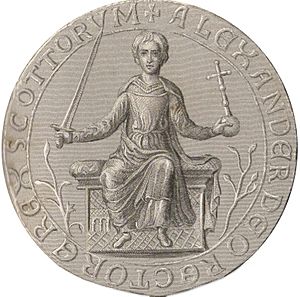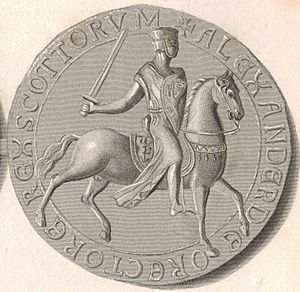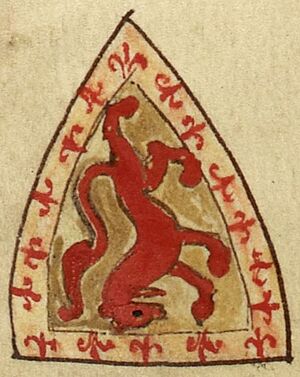Alexander II of Scotland facts for kids
Quick facts for kids Alexander II |
|
|---|---|

Great Seal of Alexander II
|
|
| King of Scotland | |
| Reign | 4 December 1214 – 6 July 1249 |
| Coronation | 6 December 1214 |
| Predecessor | William I |
| Successor | Alexander III |
| Born | 24 August 1198 Haddington, East Lothian, Scotland |
| Died | 6 July 1249 (aged 50) Kerrera, Scotland |
| Burial | Melrose Abbey |
| Spouse |
|
| Issue | Alexander III of Scotland Marjorie (illegitimate) |
| House | Dunkeld |
| Father | William the Lion |
| Mother | Ermengarde de Beaumont |
Alexander II (born August 24, 1198 – died July 6, 1249) was the King of Scotland from 1214 until his death. He is famous for signing the Treaty of York in 1237. This treaty set the border between England and Scotland, which is still mostly the same today.
Early Life and Becoming King
Alexander was born in Haddington, East Lothian, Scotland. He was the only son of King William the Lion and Queen Ermengarde de Beaumont. When he was younger, he spent some time in England. He was made a knight in 1213 by King John of England.
Alexander became King of Scotland when his father died on December 4, 1214. He was crowned king just two days later, on December 6, at Scone.
Alexander's Reign as King
Soon after Alexander became king, in 1215, some groups like the Meic Uilleim and MacHeths rebelled against the Scottish crown. But Alexander's loyal forces quickly stopped these uprisings.
In the same year, Alexander joined English nobles, called barons, who were fighting against King John of England. Alexander led his army into England to help them. This led to King John's forces attacking and damaging the Scottish town of Berwick-upon-Tweed.
The Scottish army traveled all the way to the south coast of England. In September 1216, Alexander showed his respect to Louis VIII of France. Louis was chosen by the English barons to replace King John. However, King John died, and many English nobles then supported John's young son, Henry III. This meant the French and Scottish armies had to go home.
Peace was made between Henry III, Louis, and Alexander on September 12, 1217, with the Treaty of Kingston. To make the peace stronger, Alexander married Henry III's sister, Joan, in June 1221.
In 1222, there was trouble in Caithness, a part of Scotland that was then under Norwegian rule. A local leader, Jon Haraldsson, was linked to the death of a bishop. Alexander used this chance to claim more control over the mainland part of the Orkney islands. The Pope, Pope Honorius III, praised Alexander for his actions.
Alexander also brought the area of Argyll under his control. Before this, Argyll was somewhat independent. In 1235, a rebellion in Galloway was easily put down by royal forces.
Around this time, King Henry III of England claimed that Alexander should show him loyalty. Alexander, in turn, claimed some northern English counties. But the two kings settled their differences in 1237 with the Treaty of York. This important treaty set the border between Scotland and England. It runs from the Solway Firth in the west to the mouth of the River Tweed in the east.
Alexander's first wife, Joan, died in March 1238. The next year, on May 15, 1239, Alexander married his second wife, Marie de Coucy. They had one son together, Alexander III, who was born in 1241.
In 1243, King Henry III of England threatened to invade Scotland. But Alexander quickly prepared his army. The English nobles also did not want a war. So, Henry III made peace with Alexander in 1244 at Newcastle.
Alexander then wanted to gain control of the Western Isles, which were still part of Norway. He tried to buy them or negotiate for them many times, but he was not successful. Alexander decided to conquer these islands by force.
Death
Alexander set sail to conquer the Western Isles. On his way, he tried to convince a local lord, Ewen MacDougall, to stop supporting the King of Norway. When Ewen refused, Alexander continued his journey. But he became sick with a fever on the Isle of Kerrera in the Inner Hebrides. He died there in 1249. His body was taken back to the mainland and buried at Melrose Abbey.
Stories say that before he died, Alexander had a dream. In the dream, three saints warned him not to invade the islands. But Alexander decided to continue anyway. He died shortly after, which some people saw as a punishment from God.
Alexander was succeeded by his son, Alexander III of Scotland, who was only seven years old. The dispute over the Western Isles was finally settled in 1266. At that time, the King of Norway gave the islands to Scotland.
Family
Alexander II had two wives:
- Joan of England (1210–1238). She was the daughter of King John of England. They married in 1221 when Alexander was 23 and Joan was 11. They did not have any children.
- Marie de Coucy. She became the mother of Alexander III of Scotland.
Alexander also had an illegitimate daughter named Marjorie. She married a man named Alan Durward.
See also
 In Spanish: Alejandro II de Escocia para niños
In Spanish: Alejandro II de Escocia para niños



